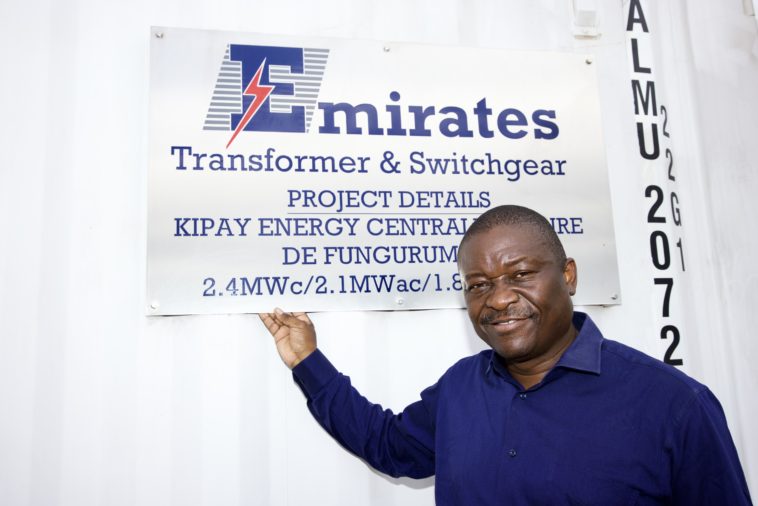He likes challenges and ignores criticism. There were many of them.
The Congolese entrepreneur Eric Monga and his partners have kept their promise, the delivery of the photovoltaic power plant in Lumbwe is expected soon. The man is in action, he expresses himself, but on his favorite field: the site of his project. An exclusive report from M&B in Fungurume.
Hello Eric Monga. Thank you for welcoming us to the site of your Fungurume photovoltaic plant. We are 100 kilometers from Kolwezi, near the Tenke Fungurume mine. At the end of December 2022, you laid the foundation stone for the construction of a solar power plant whose project is being carried out by Kipay Energy, which will produce 48 megawatts of solar energy in 2024. First of all, who will benefit from the electricity produced by the photovoltaic panels?
It’s very simple, my priority is households. Fungurume is a city that has grown from 30,000 to 300,000 inhabitants in just 10 years. Only 1% of the population has access to electricity. Initially, most of our energy production will go to the population. Later on, the solar energy produced by the Lumbwe power plant will benefit the economic operators of the region. The capacity, for the moment, is 2.4 MWp in solar energy plus 1.8 MWh in storage. Our objective is to supply the population of Fungurume by injecting the electricity produced by solar power into the SNEL network.
You are an entrepreneur and businessman also known for your great interest in energy. You are also involved in the construction of the Sombwe dam in the Mitwaba near Kiubo. What is this “energy” that motivates you?
I must remind you that in the region where we live in the DRC the energy deficit is more than 3500 megawatts, of which 1500 MW are in the mining industry. So you can imagine that any new contribution in electrical energy is welcome. Inga has been talked about for over 20 years, but it is not the only way to electrify the DRC! Kipay Energy’s ambition is to contribute to the reduction of the energy deficit in DRC.
Let’s go back to the Lumbwe power plant in Fungurume. You had to fight against a number of detractors and opposition. Can you tell us about that?
We fought against the ideas of some people, that the Congolese cannot implement such a project or even undertake complex projects. I am proud to show that we can do it. But I did not do it alone, there is a whole Congolese team behind me which is also composed of young engineers and very qualified technicians. They are the best in Congo.
The site of the power plant covers seven hectares. 78 tables each carrying 56 solar panels. You plan to produce 46 megawatts of electricity in 2024. This will be the largest private solar project in the DRC. Tell us about the beginning?
My energy projects have two components. Solar and hydro. When the water usually drops in September and October, I compensate my energy with solar. So we shut down our machines, the water rises in the tanks. I close the valve at 6am, the water rises, around 6pm we have a lot of water. And so on. During this time, I replace this energy with solar fields. They can be installed near the place where the energy enters the SNEL networks.
We started of course with studies. Once the studies were completed, the location was chosen, we moved on to ordering the material. Then we started the construction. I was very discreet so as not to attract the attention of certain opponents. I played dead. I know how to do it well.
What materials and technology did you choose?
I chose to order the solar panels directly from China. A large French panel manufacturer had given me the address of one of the best Chinese manufacturers. We made a “custom” order because we needed large panels. When we shipped the goods, there were military maneuvers in the China Sea because of the problems in Hong Kong. This delayed our ship for 35 days. When we arrived in Kasumbalesa, the goods were delayed for another 10 days because of the truck queue and the carriers’ strike. We were supposed to finish in December, we are two months behind schedule. The Fungurume solar power plant will use Tracker technology. This is a system that allows the solar panels to automatically follow the position of the sun. The automatic rotation of the solar panels can reach -55 to +55 degrees. This technology uses solar irradiation, wind and temperature sensors to track the movement of the sun in real time. The great advantage of this very innovative technology is that it will allow us to increase energy production by 10 to 15% compared to a solar power plant oriented in a single direction.the installation currently represents the largest private photovoltaic solar power plant in DRC in addition to the tracking technology. It will be connected by a transmission line to an SNEL substation, located 7 km from the concession.
We are following three stages of construction. First, Phase 1, which we will deliver in April with a photovoltaic installation that will produce 2.4 MWp. In December 2023 we will have completed Phase 2. Production will then increase to 10 MWp. And finally, in 2024 with Phase 3 where we aim to produce 46 MWp in photovoltaic. For the moment, we are in phase 1, the photovoltaic installation is 4,368 PV modules on 78 tables of which we have just celebrated the last installation. These tables are controlled by a traceability system to improve their performance. In hardware there is a battery energy storage system, a power converter as an interface between the panels and the battery for the charge and discharge of the storage system. It is important to mention that we have a positive impact on the CO2 economy with 55.470.000 kg of CO2 emissions reduced per year. I am proud to mention this.
Kipay Energy supports local expertise for innovation. You always surround yourself with young talents and you do not hesitate to entrust the development of your project expertise to young Congolese engineers and entrepreneurs.
Yes indeed. It is another pride. We have entrusted the technical expertise and the implementation of the project to Congolese companies, Smart Congo, LBK and EKMM. The strengthening of national skills is the key to success and development of the green energy sector in the DRC. And our contribution, at Kipay Energy, is to prepare the energy sector in Congo for future generations. This ability to work together for the same ideal is the best personal experience I have had in this great adventure. Through these words, I express my gratitude and thanks to all my partners and those who trust me.
From memory, the budget for the Sombwe hydroelectric power plant project in Mitwaba was around 400 million dollars. Opponents accused you of building a dam too close to a national park. What can you tell us about this?
There are several dams and projects in Congolese national parks, but ours is near a national park, not inside one. Oppositions have been lifted by the government and we are working closely with the ICCN.
Like the Fungurume solar power plant project, this project meets the objectives
objectives set by the President of the DRC in his action plan for the development of the
145 territories. The objective is to provide concrete solutions for the
water, electricity, education and road infrastructure. It is important to note that
It is important to note that the energy deficit in the Congo is abysmal. Less than
less than 10% of the population has access to electricity and less than 1% of the population in
population in rural areas. The population of the territory also gave us their support
their traditional chiefs, and priests, all those who believed in this idea.
believed in this idea. That’s the first thing. Then, there is nothing less polluting
that hydraulic energy, this being the case, the component for the conservation of nature is an integral part of the project.
Integral part of the project. We are very attached to the protection of the environment
the environment, to its conservation. We have worked and elaborated an Environmental and Social.
We have worked on and developed an Environmental and Social Impact Assessment (ESIA) to assess the impact of the Sombwe project.
Stakeholders are all involved and our priority is to ensure transparent communication of all transparent communication of all consultations www.sombwedialogue.com. I would like to add that this is a Congolese project and it is being carried out by the best people in the Congo, as well as the best expertise and skills from outside. Scientists, engineers, topographers, geologists, field workers. The hydroelectric power plant will produce 166 MW of electricity that will be transmitted by a 206 km high voltage line linking Sombwe to the Fungurume sub-station.
Green energy is now a challenge for the sustainable socio-economic development of the DRC.
I note that I have been subjected to a lot of pressure, threats (get off my back) as well as racist and untruthful remarks because I am black and Congolese.
One last question, what does Kipay mean?
(Laughs) Ah, that’s a good question: a name, a philosophy, a symbol that designates the copper mountain!

